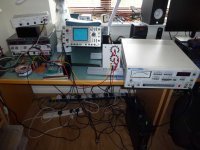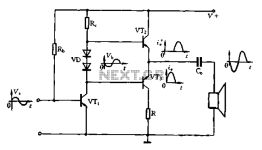A slightly different circuit strategy was described in Linear Audio - Volume 2. In it Kendall Castor-Perry described a concept labelled 'Class i'. The picture shows a prototype that uses the idea. It doesn't require any presets or adjust on test resistors and the output is Class A/B and provides a relatively smooth transition cross over transition.
Attachments
Then I suck. I must REALLY suck, because every serious non-tube amp I made for the last 30 years has an op amp front end. There were literally just a handful that didn’t, and the biggest of those was 40 wpc.in an Italian forum a person wrote the following bold statement: those who use opamps that drive power transistors or mosfets suck. what do you say?
None of those circuits directly drive power transistors with the op amp. There’s two stages in between. And the only thing that really changes are whether those stages in between are single ended, push pull, or where the local feedback is applied.
The real reason I “suck“ is because my priorities are different from everybody else’s. Building amps that would be considered dinosaurs today, using a mix of modern and prehistoric technology. Is anybody else here even interested in amps that can do 5000 undistorted watts short term (as in 30 seconds not 30 milli seconds), and deliver 2000 long term heating equivalent average? Nobody interested in home hi fi - Not even the pro guys anymore. Especially if the damn thing weighs 90 pounds.
Not always. We had a visitor over here recently who designs tube amps, a friend of NP. He said he couldn't believe there wasn't a tube somewhere in the system here because it sounds so good. Its all discrete bipolar and class AB...however, there are some prototype line-level transformers 🙂Compared to tubes, transistors sound baked, doughy: Material and potted.
😉
I had built someone a small 2-stage complementary push-pull, something like below. The buyer was of the opinion that this box sounded like his 300B;-)
I meant the comparison of components, not of circuits. But you can also track down the sound of circuits;-)
I had built someone a small 2-stage complementary push-pull, something like below. The buyer was of the opinion that this box sounded like his 300B;-)
I meant the comparison of components, not of circuits. But you can also track down the sound of circuits;-)
Attachments
I say that all good amplifiers sound the same regardless of how they were designed.
Ed
But that's only your opinion - and, as the saying goes - "... everyone has one"! 😀
I have heard different amplifiers ... that sound different!
I have heard different amplifiers ... that sound different!
And you know that they were all very good designs with comparable distortion level, DF, harmonic profile, power bandwidth, noise level …. ? 😀
And you know that they were all very good designs with comparable distortion level, DF, harmonic profile, power bandwidth, noise level …. ? 😀
Actually ... yes! 😵
My current amps are from the same designer (Hugh Dean). I have a pair of 80w-into-8-ohms stereo Class AB amps (his 'NAKSA 80s') for summer use - which run cool - and a pair of stereo 40w-into-4-ohms Class A amps ... which are my winter amps, as they put out a lot of heat.
I prefer listening to the Class A amps.
I recommend listening comparisons with e.g. music videos: The sounds associated with images, e.g. expected sounds, often make a comparison easier;-)
Obi Wan’s warning : “Your eyes can deceive you, don't trust them”.
Watching a music video or concert performance you can often “hear” an instrument that’s buried in the noise (or isn’t even in the MIX) just because you see it being played. And the audio/video codecs used on the internet are about as good as the LM386 on 4 ohms.
I really wish people who show how “good” their amplifier/speaker is on youtube would just stop doing that.
Watching a music video or concert performance you can often “hear” an instrument that’s buried in the noise (or isn’t even in the MIX) just because you see it being played. And the audio/video codecs used on the internet are about as good as the LM386 on 4 ohms.
I really wish people who show how “good” their amplifier/speaker is on youtube would just stop doing that.
Well, it will put out about the same power, and VT1 operating without a bootstrap has a LOT of 2HD. Probably a DF of about 1 with no NFB. With a good set of modern sustained beta outputs, and the diodes selected to give say 100 mA of bias current the whole characteristic is going to be dominated by that first stage. Will it sound like a 300B? Probably more like one than your typical SS amp.😉
I had built someone a small 2-stage complementary push-pull, something like below. The buyer was of the opinion that this box sounded like his 300B;-)
I meant the comparison of components, not of circuits. But you can also track down the sound of circuits;-)
I have certainly heard amplifiers that sounded different. They were not good. 😉I have heard different amplifiers ... that sound different!
Ed
Does this prove anything? 😎
Beyond Peter Gabriel talent that is. 👍
Maybe no amplifiers are good if they sound a little different with very difficult loads (including for stereo imaging of real music, or of equivalent multi-tone test signals)?They were not good.
Maybe a real world load like this:
IME not all "good" amplifiers sound equally good with all loads. That includes Benchmark AHB2.
Last edited:
I've always admired Gerald Stanley who was at Crown International for his circuit designs and patents. One of the first engineers who understood the powers of negative feedback and used it well for solid state . Some of his patents include Class AB+B, Output Device Emulation Protection, Grounded Bridge and Opposed Current Converter come to mind Very, very clever.
What problem? My Sound Lab Majestic series ESL panels (different series from A-1 but still a bit of a challenge to drive) sound very good with dual Marantz MA9-S2 mono blocks. Can't say the same for some other amps I have tried. Some are better than others though....the problem...
BTW, a friend may have a pair of MA9-S2 if anyone is interested. For this guy, 300W/channel @8R is not enough power.
https://www.crutchfield.com/S-Y9MZO7LnOcT/p_642MA9S2/Marantz-Reference-Series-MA-9S2.html
Last edited:
- Home
- Amplifiers
- Solid State
- circuit strategies of power amplifiers

